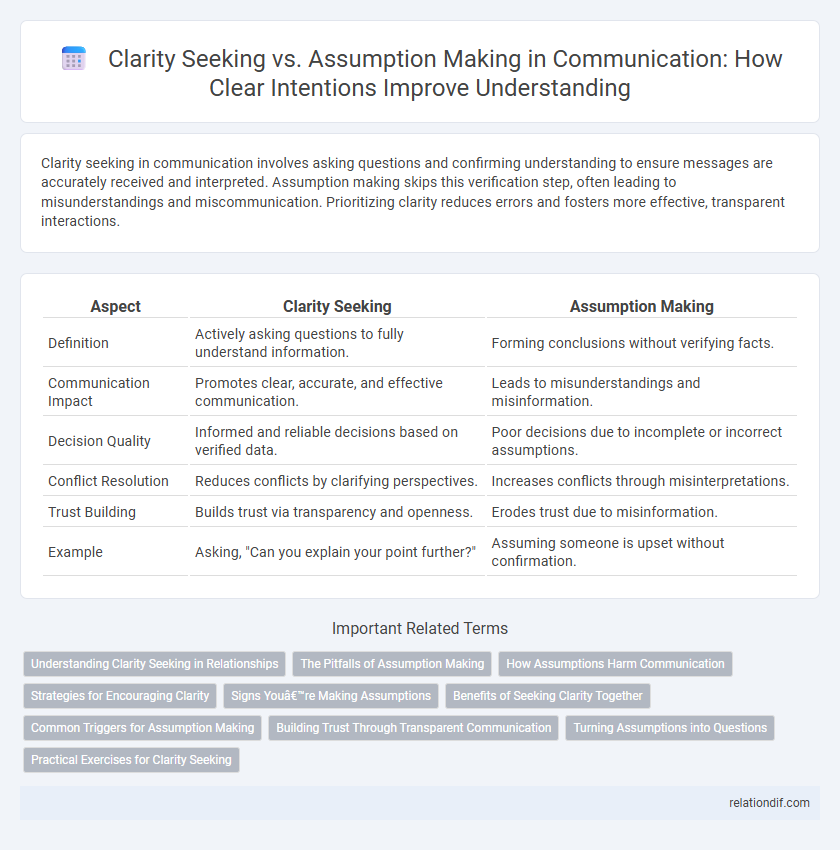Clarity seeking in communication involves asking questions and confirming understanding to ensure messages are accurately received and interpreted. Assumption making skips this verification step, often leading to misunderstandings and miscommunication. Prioritizing clarity reduces errors and fosters more effective, transparent interactions.
Table of Comparison
| Aspect | Clarity Seeking | Assumption Making |
|---|---|---|
| Definition | Actively asking questions to fully understand information. | Forming conclusions without verifying facts. |
| Communication Impact | Promotes clear, accurate, and effective communication. | Leads to misunderstandings and misinformation. |
| Decision Quality | Informed and reliable decisions based on verified data. | Poor decisions due to incomplete or incorrect assumptions. |
| Conflict Resolution | Reduces conflicts by clarifying perspectives. | Increases conflicts through misinterpretations. |
| Trust Building | Builds trust via transparency and openness. | Erodes trust due to misinformation. |
| Example | Asking, "Can you explain your point further?" | Assuming someone is upset without confirmation. |
Understanding Clarity Seeking in Relationships
Clarity seeking in relationships fosters open communication by encouraging individuals to ask questions and express their thoughts clearly, reducing misunderstandings and building trust. Prioritizing clarity helps partners align their expectations and emotions, creating a more supportive and empathetic environment. Misinterpretations stemming from assumption making often lead to conflicts, emphasizing the importance of verifying intentions and feelings for healthier connections.
The Pitfalls of Assumption Making
Assumption making in communication often leads to misunderstandings, as it bypasses the verification of facts and intentions. Relying on assumptions can create false narratives that distort the original message, reducing overall clarity and effectiveness. Clarifying questions and active listening prevent misinterpretations, fostering accurate information exchange and stronger interpersonal connections.
How Assumptions Harm Communication
Assumption making in communication often leads to misunderstandings and misinformation, as individuals interpret messages based on personal biases rather than factual clarification. This practice undermines trust and creates barriers to effective dialogue, resulting in conflict and inefficiency. Prioritizing clarity by asking questions and verifying information fosters accurate understanding and stronger interpersonal connections.
Strategies for Encouraging Clarity
Effective communication relies on strategies that promote clarity and minimize assumption-making, such as asking open-ended questions and actively paraphrasing the speaker's message to ensure understanding. Encouraging feedback loops and summarizing key points helps to confirm accurate interpretation, reducing the risk of miscommunication. Implementing these techniques fosters a transparent dialogue environment where clarity is prioritized over presumptions.
Signs You’re Making Assumptions
Misinterpreting others' intentions or emotions often signals assumption making in communication, leading to misunderstandings and conflicts. Relying on incomplete information or ignoring requests for clarification indicates a tendency to assume rather than seek clarity. Recognizing vague or inconsistent responses as prompts to ask questions helps avoid miscommunication and fosters more effective interactions.
Benefits of Seeking Clarity Together
Seeking clarity together fosters mutual understanding and reduces miscommunication, which enhances collaboration and decision-making effectiveness. By openly discussing intentions and expectations, teams build trust and create a transparent communication environment. This proactive approach minimizes errors and promotes shared accountability, driving better project outcomes.
Common Triggers for Assumption Making
Common triggers for assumption making in communication include ambiguous language, incomplete information, and emotional biases. These factors lead individuals to fill gaps with personal interpretations, often distorting the intended message. Recognizing these triggers helps promote clarity seeking and reduces misunderstandings.
Building Trust Through Transparent Communication
Building trust through transparent communication hinges on clarity seeking rather than assumption making, fostering openness and reducing misunderstandings. Clear, direct exchanges enable individuals to align expectations and demonstrate reliability, which strengthens professional and personal relationships. Transparent communication creates a foundation for trust by prioritizing honest dialogue and confirming understanding.
Turning Assumptions into Questions
Turning assumptions into questions enhances communication clarity by transforming uncertain beliefs into opportunities for verification. This approach reduces misunderstandings and fosters a collaborative environment where ideas are explored openly. Asking clarifying questions encourages active listening and ensures alignment between all parties involved.
Practical Exercises for Clarity Seeking
Practical exercises for clarity seeking include techniques such as paraphrasing, asking open-ended questions, and summarizing key points to ensure mutual understanding. Role-playing scenarios and active listening drills enhance the ability to identify ambiguities and prevent assumption-based misunderstandings. Consistent practice in these methods fosters clearer communication, reducing errors and improving interpersonal effectiveness.
Clarity seeking vs Assumption making Infographic

 relationdif.com
relationdif.com